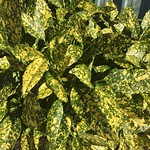Resource Library
Plant of the Week: Gold Dust Aucuba
The University of Arkansas System Division of Agriculture does not promote, support or recommend plants featured in "Plant of the Week." Please consult your local Extension office for plants suitable for your region.
Plant of the Week
Gold Dust Aucuba
Latin: aucuba japonic 'Variegata'

OK, I admit it. I like variegated plants -- generally the gaudier the variegation
the better.
Not all of my gardening friends agree and several have suggested I attend Variegated
Anonymous, but so far I’ve convinced myself I don’t have a problem. It seems to me
that the more ornamental characteristics a plant has, the better it is. It must be
a character flaw because I use the same principle when building an omelet -- the more
stuff you add the better it is. Subtlety is lost on me.
The gold dust aucuba is a 6-foot tall evergreen shrub with rich green, gold spotted
leaves that are two inches wide and seven inches long. While officially hardy only
as far north as zone 7 in Arkansas, sudden temperature drops, such as we experienced
in the mid 80's, can cause severe injury even there.
Aucuba is native to Japan and China and was introduced to England in 1783 by John
Graeffer. It was brought to the United States in the 1860's by Robert Hall, the same
person who was unfortunate enough to introduce Hall’s honeysuckle, which now runs
rampant across the eastern U.S. woodlands.
Aucuba is a member of the dogwood family. It produces small, rather insignificant
four-petaled brownish blooms in the tops of the plant in the spring. Individual plants
may be either male or female. The female plants, provided a male is around for pollination,
produce clusters of bright red, inch-long fruit in the fall and winter.
The golden variegation patterns are inherited from momma. If the female plant is
variegated, the seedlings will be variegated regardless of what the male looks like.
If the female plant is green and papa is variegated, the seedlings will be green.
This indicates that the cause of variegation is not under the control of the DNA of
the nucleus but probably under the control of the chloroplasts where photosynthesis
occurs. Chloroplasts float in the juices of each cell and are inherited from the female
parent.
Aucubas require shade. While many of the plants we grow in the garden simply tolerate
shade, gold dust aucuba must have it. If exposed to full sun the leaves burn severely
and turn a nice crunchy black. It maintains a nice compact form in the shade with
its yellow variegated leaves glowing throughout the summer months when contrasted
with the green backdrop of other shrubs and trees.
Aucubas should be planted in a reasonably fertile, well drained soil that can be
watered during dry weather. They respond well to fertilization, but fertilizer should
not be used with reckless abandon as it can encourage soft growth and increase the
chance of winter injury.
If plants are overgrown, shear them back in the spring just before growth begins.
The trimmings root easily -- I’ve seen them root even in water.
By: Gerald Klingaman, retired
Extension Horticulturist - Ornamentals
Extension News - July 9, 1999
The University of Arkansas System Division of Agriculture does not maintain lists of retail outlets where these plants can be purchased. Please check your local nursery or other retail outlets to ask about the availability of these plants for your growing area.